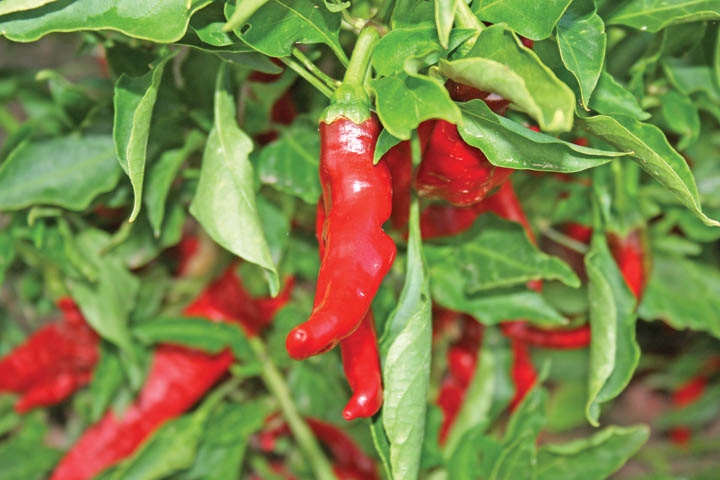
With New Mexico chile harvest just a couple of weeks away, early indications are the 2012 crop will be smaller than expected. Growers and Extension specialists say water shortages and foreign competition are the major pitfalls to what they hoped would be a bumper year.
Overall, chile acres have increased across the state in recent years, from 8,500 acres in 2010 to 10,000 in 2011. While the total number of chile acres this year is yet unknown, Jaye Hawkins, New Mexico Chile Association (NMCA) administrator, reported earlier this year that less water from the Rio Grande and pressure from foreign chile growers is hurting this year’s prospects. But she says so far she remains cautiously optimistic that once harvest is complete, chile numbers but will be close to last year’s yield.
In spite of that optimism, no one argues that this year has been a challenge for growers. The semi-arid chile growing areas of Southern New Mexico particularly were heavily affected by an International Boundary & Water Commission’s (IBWC) decision to release water from the Rio Grande River to Mexico in April, a move that limited the amount of water allotted to irrigation districts in the southern part of the state. Under terms of that plan, millions of gallons of water were released to Mexico from Elephant Butte Reservoir, forcing irrigation districts to ration water to New Mexico and Texas agriculture users.
Chile growers were forced to rely on ground water to irrigate, increasing production costs and affecting the total number of acres planted.
According to Jeff Anderson, Doña Ana County horticulture Extension agent, a drive across his district seems to indicate fewer planted acres compared to last year.
“We won’t know the final number until USDA releases that information early next year, but I am not seeing as many acres of chiles as I did last year. I think our chile production is going to be down as a result,” Anderson reports.
The bigger problem, however, appears to be the impact of foreign chile production, especially across the border in Mexico. Hawkins and Anderson agree that since the ratification of the North American Free Trade Agreement (NAFTA) in 1994, foreign-grown chile has presented a challenge to New Mexico’s chile industry because their product can be sold for less.
Labor issues
“New Mexico growers have a hard time finding the labor to hand pick the green chile the state is known for. Labor in Mexico is readily available and cheap, so their production costs are extremely low, and this gives them an advantage in the market,” says Hawkins. “Many New Mexico growers are giving up their chile acres in favor of other, more profitable crops, like cotton, and the decline has been steady since NAFTA was approved.”
She says foreign imports now account for 80 percent of all chile consumed domestically, creating a radically different market than in pre-NAFTA days. In addition, younger New Mexico growers are giving up a long-held tradition of growing chile because of foreign competition.
��“The number of acres produced each year is driven by contract production, meaning the crop is sold before it is ever planted. No one is really willing or able to farm chile on speculation anymore. There is just too much competition from foreign imports,” she added.
Red chile growers in New Mexico remain price competitive because red chile can be harvested by machine, while green chile still relies on manpower.
“A great deal of research and testing is taking place in an attempt to mechanize green chile farming and eventually we hope this will even up the odds to the competition of cheaper chile grown in Mexico and South America. But being able to survive the wait may be more than New Mexico growers can handle. Production costs are going up and then drought conditions and the lack of water makes it nearly impossible to produce a profitable crop,” Hawkins said.
For a few green chile growers, a healthy local market has helped sustain them through the difficult years of NAFTA. Hawkins says when it comes to flavor, New Mexicans insist on locally grown chile, and that has helped to keep the state’s chile industry alive.
In addition to foreign competition and lack of available water for irrigation, Anderson said hail storms earlier this year damaged a number of chile fields around Las Cruces.
“Some fields were wiped out, some had damage and others were completely missed by the hail storms,” he said. “In addition, chile growers have pumped so much ground water for irrigation that the water table has dropped some 40 feet and the only water they can pump in some areas is high in salt content. We really need substantial rain and good snow melt next year if we hope to recover from the current drought.”
A new New Mexico Chile Association campaign launched earlier this year promoting state-grown chile is expected to have a positive impact. But even so, Hawkins fears that unless mechanized green chile farming can be adapted and water issues can be resolved, the road ahead for New Mexico chile growers could be a difficult one.
About the Author(s)
You May Also Like






